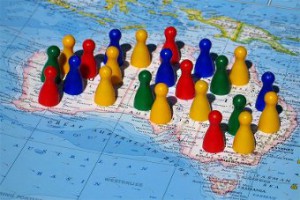While Australia’s population continues to grow, it is at a slower pace than the highs recorded a few years ago. In a precursor to the release of 2011 Census data tomorrow, the ABS today released the quarterly publication Australian Demographic Statistics (Cat.no. 3101.0). The release of this publication is notable because the data has been re-based using the results of the 2011 Census. What are the highlights from this release?

2011 – the year that was
- At December 2011, Australia’s population was 22,485,300. This represents an increase of 1.4% on the previous year, and total growth of 302,600.
- The volume of growth recorded in 2011 is higher than 2010 (254,100 – 1.2%) but much lower than the record level recorded in 2008 (409,100 – 1.9%).
- Victoria recorded the highest volume of growth in the last twelve months (75,000). Despite this, both the rate (1.4%) and volume are lower than those recorded in the heady years of 2008 and 2009.
- Western Australia recorded the highest growth rate over the last twelve months (2.9%), more than twice the national average! Interestingly, the volume of growth in Western Australia (67,400) just outpaced that of Queensland (66,500). This is interesting for two reasons – firstly, this hasn’t happened since the late 1960s and is clearly related to the mining boom in the north of the State. Secondly, demographers have long been aware of the decline in the level of interstate migration to Queensland and while it’s simplistic to suggest growth has diverted west rather than north, it’s interesting to speculate on what other demographic and cultural shifts are influencing this trend.
Strong growth, or not so strong growth?
The population estimates included in this latest population release by the ABS have been re-based on the results of the 2011 Census. This means that the previous June 2011 population estimates we’ve all come to know and love, which were based on 2006 Census data, have changed in line with data collected in the 2011 Census.
The re-based data shows that Australia’s population at June 2011 was 22,323,900 and that the annual average growth rate over the previous five years was 1.5%. This compares to a rate of 1.3% in the period 2001-06.
Overall, the inter-censal discrepancy for Australia is estimated to be 294,400. This means that the June 2011 ERP based on the 2006 Census was almost 300,000 higher than the re-based 2011 estimate. In other words, the amount of growth in Australia has been slightly overestimated by about 1.3% over the five years. The table below compares the population figures for Australia’s States and Territories at June 2011, one based on 2006 Census and the other on 2011 Census.
Source: ABS, Australian Demographic Statistics (Cat. no. 3101.0)
Clearly, the estimates of intercensal discrepancy varies significantly across the country and is highest in the three largest States – NSW, Victoria and Queensland. The adjustments for Queensland are interesting – the ABS has overestimated the population by over 106,000 and this represents a discrepancy of 2.4%, almost twice the national figure. Interestingly, South Australia had a significant discrepancy for a slow growing state (1.1%) but the discrepancy in WA, Tasmania, NT and the ACT was negligible.
This is interesting given the attention in the media and politics to the challenges of a big Australia and how to manage record levels of growth. Year on year trends aside, the reality is that the rate of growth as measured over a five year period is not a lot higher than that recorded in the first half of the decade.
The upshot of these adjustments will be made clearer at the end of July when the ABS releases the 2011 rebased ERPs for smaller levels of geography. This includes LGAs but also the estimates made on the new geography standard, the ASGS. At .id we are very interested in the new LGA estimates as it gives our forecasters new information to work with.
Though today’s release is a bit of a taster, of course the really interesting stuff is released tomorrow. How are our cities and towns changing? Are there really that many more children running around? What is going on in Queensland? Are any parts of Sydney and Melbourne losing population? Has there been an increase in the Icelandic population? And of course – how many people put Jedi on their Census form? (OK so perhaps that one will remain a mystery!)
To follow .id’s analysis of the 2011 Census results as they are released, sign up for email or twitter notifications in the sidebar.












